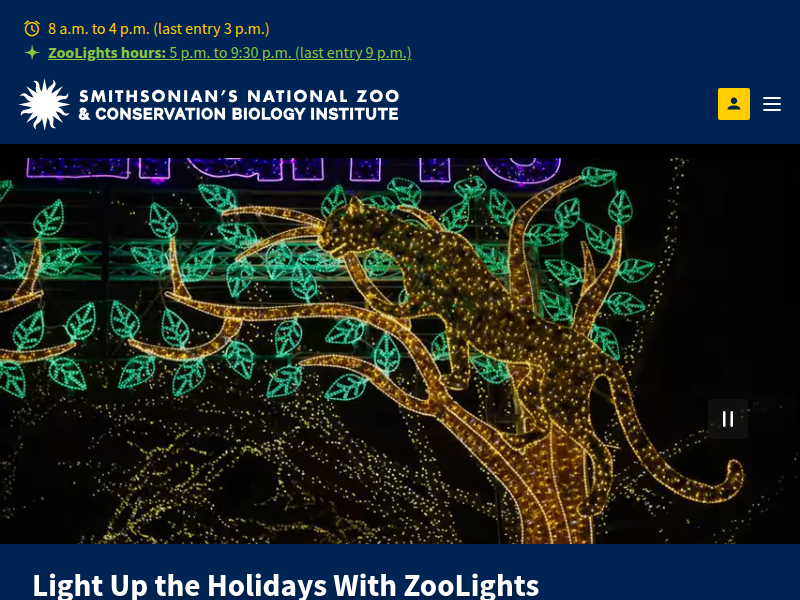Dein Suchergebnis zum Thema: elsen
Meintest du essen?
New at the Zoo: Emperor Tamarins | Smithsonian’s National Zoo and Conservation Biology Institute https://nationalzoo.si.edu/animals/news/new-zoo-emperor-tamarins
Meet Fleck and Poe, a pair of emperor tamarin brothers who recently made their debut in Amazonia’s rainforest habitat! Get to know these mischievous monkeys from animal keeper Denny Charlton.
Learn what else makes these animals unique.
Claws & Paws Pathway https://nationalzoo.si.edu/animals/exhibits/claws-paws-pathway
Meet binturongs, bobcats, Pallas‘ cats and porcupines along Claws & Paws Pathway.
These animals have something else in common… they stink!
Elephant Update: Spike Settles In | Smithsonian’s National Zoo and Conservation Biology Institute https://nationalzoo.si.edu/animals/news/elephant-update-spike-settles
This update was written by elephant keeper Kayleigh Sullivan. It has been almost a week since Asian elephant Spike arrived at the Elephant Trails habitat. Since then, he has made himself right at home!
She is a familiar face for him when almost everything else in his environment is
The Hidden Life of Vernal Pools | Smithsonian’s National Zoo and Conservation Biology Institute https://nationalzoo.si.edu/conservation/news/hidden-life-vernal-pools
Spring has arrived, and vernal pools are surging with life. Learn what makes these temporary wetlands ideal for wood frogs, spotted salamanders and other woodland species.
Vernal pool obligates are unable to complete their life cycle anywhere else.
New at the Zoo: Hawk-Headed Parrot | Smithsonian’s National Zoo and Conservation Biology Institute https://nationalzoo.si.edu/animals/news/new-zoo-hawk-headed-parrot
Get to know the Zoo’s hawk-headed parrot, Boomer, in this Q&A with animal keeper Hilary Colton.
Learn what else makes these animals unique.
Reconecta: Bridging the Gap for Amazonian Wildlife | Smithsonian’s National Zoo and Conservation Biology Institute https://nationalzoo.si.edu/ccs/reconecta-canopy-project
Always free of charge, the Smithsonian’s National Zoo is one of Washington D.C.’s, and the Smithsonian’s, most popular tourist destinations, with more than 2 million visitors from all over the world each year. The Zoo instills a lifelong commitment to conservation through engaging experiences with animals and the people working to save them.
incredibly rich and biodiverse region, home to thousands of species found nowhere else
A New Tool for Saving Asian Elephants and Other Large Species | Smithsonian’s National Zoo and Conservation Biology Institute https://nationalzoo.si.edu/conservation-ecology-center/news/new-tool-saving-asian-elephants-and-other-large-species
Large animals, like the Asian elephants, have evolved to grow and mature at a different rate than many smaller species monitored by organizations like the International Union for the Conservation of Nature (IUCN).
“It should become part of the toolkit, going along with everything else we use.
New at the Zoo: Wiggly and Wonderful Caecilians | Smithsonian’s National Zoo and Conservation Biology Institute https://nationalzoo.si.edu/animals/news/new-zoo-wiggly-and-wonderful-caecilians
With a sleek, eel-like body and beady eyes, the aquatic caecilian is quite an unusual amphibian. In this Q&A, animal keeper Denny Charlton shares some of his favorite fun facts about these wiggly wonders.
Learn what else makes these animals unique.
Focus on the Future: Alyssa Wetterau Kaganer | Smithsonian’s National Zoo and Conservation Biology Institute https://nationalzoo.si.edu/conservation/news/focus-future-alyssa-wetterau-kaganer
Focus on the Future is a series that seeks to highlight the early career scientists who conduct research at the Smithsonian’s National Zoo and Conservation Biology Institute.
though the vaccinations didn’t work the way we expected, it means there is something else

